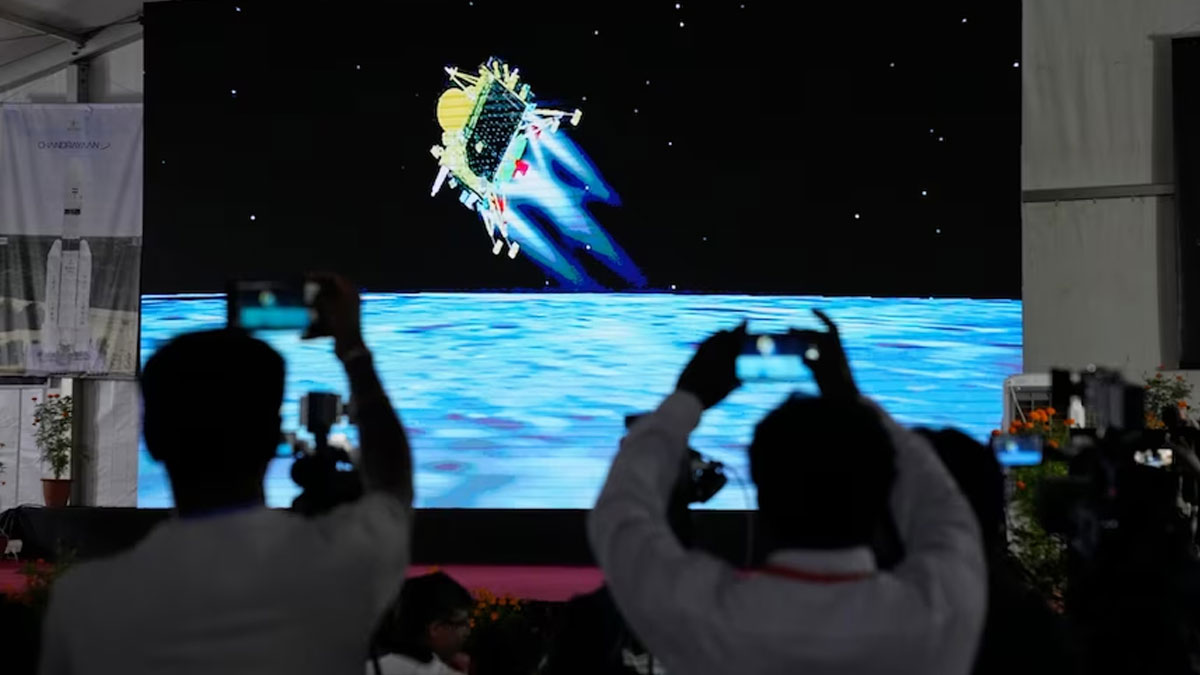
India has become the first country to land near the Moon's south pole, just days after a Russian spacecraft crashed trying to reach the area.
The spacecraft Chandrayaan-3 will now spend two weeks looking for frozen water, which could support astronauts on future Moon and Mars explorations.
India Prime Minister Narendra Modi hailed the success, while scientists and officials clapped, cheered and hugged each other as the spacecraft landed.
"This moment is unforgettable. It is phenomenal. This is a victory cry of a new India," said Prime Minister Narendra Modi, who was seen waving the Indian flag as he watched the landing from South Africa.
"India is now on the moon. India has reached the south pole of the moon — no other country has achieved that. We are witnessing history."
The success puts India in the league of space powers, and it's become only the fourth country to successfully land on the Moon following US, China and the former Soviet Union.
This was India's second attempt to land a spacecraft on the moon and comes less than a week after Russia's Luna-25 mission failed.
The south pole — far from the equatorial region targeted by previous missions, including the crewed Apollo landings — is full of craters and deep trenches.
Nation brought to a standstill
The country stood still as the spacecraft landed, watching at planetariums, science centres, and parties around India.
Jyothi, a physics student at Delhi University, watched with friends at the city's Nehru Planetarium.
"As a country, I think it's very important because although we have a very good space program, India is considered a very under-developed country," the 20-year-old said.
"This is a big landmark, we have the potential, we have the talent, and now we're doing it."
Kanishka, 20, said the achievement would boost India's global reputation.
"India is slowly growing and it's becoming one of the major powers of the world so we have to prove ourselves at every platform that we can and this is one of them," she said.
"So fulfilling the landing today, it's a great moment."
One mother who brought her young daughter to watch the landing said it was a win for young Indians.
"This is going down in history, so for my daughter to visit this is an experience… she should see it for herself for the future," she said.
"This goes a long way, but for my daughter to come here and see this and be a proud Indian, there's nothing like it, we are overwhelmed."
Mission just beginning
Chandrayaan means "moon vehicle" in Hindi and Sanskrit. It took off from a launch-pad in Sriharikota in southern India on July 14.
In 2019, ISRO's Chandrayaan-2 mission successfully deployed an orbiter but its lander crashed.
The Chandrayaan-3 is expected to remain functional for two weeks, running a series of experiments including a spectrometer analysis of the mineral composition of the lunar surface.
The moon rover will take a few hours or a day to come out of the spacecraft, said S Somanath, chief of the Indian Space Resaerch Organisation(ISRO).
Rough terrain makes a south pole landing difficult, and a first landing is historic.
The region's ice could supply fuel, oxygen and drinking water for future missions.
"Landing on the south pole (of the moon) would actually allow India to explore if there is water ice on the moon," said Carla Filotico, a partner and managing director at consultancy SpaceTec Partners.
"And this is very important for cumulative data and science on the geology of the moon."
The landing has given India confidence to extend its reach to possible voyages to Mars and Venus, Mr Somanath said.
He also said India would next attempt a manned lunar mission.
Win for Modi government
The landing is also a win for Mr Modi's government which is showing off India as a leader in technology and an assertive global superpower.
A successful moon mission dovetails with Mr Modi's image of an ascendant India asserting its place among the global elite and would help bolster his popularity ahead of a crucial general election next year.
Critics of the mission have questioned its importance while hundreds of millions of Indians are still battling rough living conditions.
"This achievement marks a significant step forward for Indian Science, Engineering, Technology, and Industry, symbolising our nation's progress in space exploration," the Indian Space Research Organisation said in a statement earlier on Wednesday.
It said that a successful Chandrayaan-3 landing would be monumental in fuelling curiosity and sparking a passion for exploration among youth.
"It generates a profound sense of pride and unity as we collectively celebrate the prowess of Indian science and technology," the organisation said.
The landing is also expected to boost India's reputation for cost-competitive space engineering.
The Chandrayaan-3 was launched with a budget of about 6.15 billion rupees ($114 million), far lower than those of other countries.
Experts say India can keep costs low by copying and adapting existing technology, and thanks to an abundance of highly skilled engineers who earn a fraction of their foreign counterparts' wages.
By ABC/Wires
Original article link: https://www.abc.net.au/news/2023-08-23/india-moon-lander-makes-historic-landing-on-moon/102768378
Stay tuned for the latest news on our radio stations


